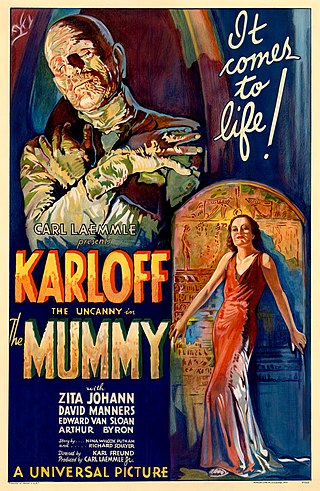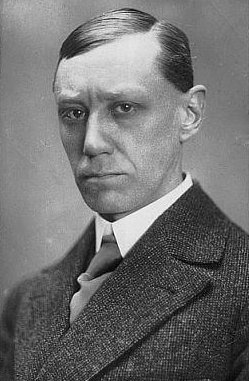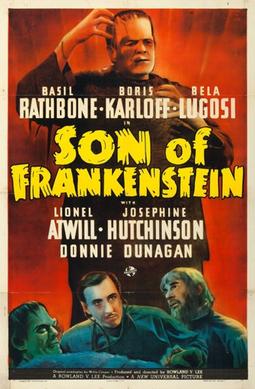Related Research Articles

Béla Ferenc Dezső Blaskó, known professionally as Bela Lugosi, was a Hungarian and American actor best remembered for portraying Count Dracula in the 1931 horror classic Dracula, Ygor in Son of Frankenstein (1939) and his roles in many other horror films from 1931 through 1956.

Abbott and Costello Meet Frankenstein is a 1948 American horror comedy film directed by Charles Barton. The film features Count Dracula who has become partners with Dr. Sandra Mornay, as Dracula requires a "simple, pliable" brain to reactivate Frankenstein's monster. Dracula discovers that the "ideal" brain belongs to Wilbur Grey who is wooed by Mornay to the operating table, despite the warnings of Lawrence Talbot.

Frankenstein is a 1931 American pre-Code science fiction horror film directed by James Whale, produced by Carl Laemmle Jr., and adapted from a 1927 play by Peggy Webling, which in turn was based on Mary Shelley's 1818 novel Frankenstein; or, The Modern Prometheus. The Webling play was adapted by John L. Balderston and the screenplay written by Francis Edward Faragoh and Garrett Fort, with uncredited contributions from Robert Florey and John Russell.

Nosferatu: A Symphony of Horror is a 1922 silent German Expressionist horror film directed by F. W. Murnau and starring Max Schreck as Count Orlok, a vampire who preys on the wife of his estate agent and brings the plague to their town.

The Mummy is a 1932 American pre-Code supernatural horror film directed by Karl Freund. The screenplay by John L. Balderston was adapted from a treatise written by Nina Wilcox Putnam and Richard Schayer. Released by Universal Studios as a part of the Universal Classic Monsters franchise, the film stars Boris Karloff, Zita Johann, David Manners, Edward Van Sloan and Arthur Byron.

Friedrich Gustav Maximilian Schreck, known professionally as Max Schreck, was a German actor, best known for his lead role as the vampire Count Orlok in the film Nosferatu (1922).

Count Orlok, commonly known as Nosferatu, is the main antagonist and title character portrayed by German actor Max Schreck (1879–1936) in the silent film Nosferatu, eine Symphonie des Grauens (1922). He was based on Bram Stoker's character Count Dracula.

Dracula is a 1931 American pre-Code supernatural horror film directed and co-produced by Tod Browning from a screenplay written by Garrett Fort and starring Bela Lugosi in the titular role. It is based on the 1924 stage play Dracula by Hamilton Deane and John L. Balderston, which in turn is adapted from the 1897 novel Dracula by Bram Stoker. Lugosi portrays Count Dracula, a vampire who emigrates from Transylvania to England and preys upon the blood of living victims, including a young man's fiancée.

Victor Frankenstein is a fictional character and the main protagonist and title character in Mary Shelley's 1818 novel, Frankenstein; or, The Modern Prometheus. He is an Italian-Swiss scientist who, after studying chemical processes and the decay of living things, gains an insight into the creation of life and gives life to his own creature. Victor later regrets meddling with nature through his creation, as he inadvertently endangers his own life and the lives of his family and friends when the creature seeks revenge against him. He is first introduced in the novel when he is seeking to catch the monster near the North Pole and is saved from near death by Robert Walton and his crew.

Son of Frankenstein is a 1939 American horror film that was directed by Rowland V. Lee and stars Basil Rathbone, Boris Karloff and Bela Lugosi. The film is the third in Universal Pictures' Frankenstein series and is the follow-up to the 1935 film Bride of Frankenstein. Son of Frankenstein stars Rathbone as Baron Wolf von Frankenstein who, with his wife Elsa and son Peter, return to his late father's estate. Near the castle lives Ygor, a crazed blacksmith whose neck was broken in an unsuccessful hanging attempt. Among the castle's remains, Frankenstein discovers the remains of the monster and decides to try to save his family name by resurrecting the creature to prove his father was correct. He finds, however, the monster only responds to Ygor's commands.

Son of Dracula is a 1943 American horror film directed by Robert Siodmak with a screenplay based on an original story by his brother Curt Siodmak. The film stars Lon Chaney, Jr., Louise Allbritton, Robert Paige, Evelyn Ankers, and Frank Craven. The film is set in the United States, where Count Alucard has just taken up residence. Katherine Caldwell (Allbritton), a student of the occult, becomes fascinated by Alucard and eventually marries him. Katherine begins to look and act strangely, leading her former romantic partner Frank Stanley (Paige) to suspect that something has happened to her. He gets help from Dr. Brewster (Craven) and psychologist Laszlo who come to the conclusion that Alucard is a vampire.

House of Frankenstein is a 1944 American horror film starring Boris Karloff, Lon Chaney Jr. and John Carradine. The film was directed by Erle C. Kenton based on a story by Curt Siodmak, and produced by Universal Pictures. The film is about Dr. Gustav Niemann who escapes from prison and promises to create a new body for his assistant Daniel. The two murder Professor Lampini and take over his sideshow that involves the corpse of Count Dracula. After disposing of the Count, the two move on to the ruins of Castle Frankenstein where they find the body of Frankenstein's monster and The Wolf Man Larry Talbot preserved in the castle. Niemann thaws them and promises to cure Talbot of his werewolf curse, but secretly plots to revive Frankenstein's monster instead.

House of Dracula is a 1945 American horror film released and distributed by Universal Pictures. Directed by Erle C. Kenton, the film features several Universal Horror properties meeting as they had done in the 1944 film House of Frankenstein. The film is set at the castle home of Dr. Franz Edelmann, who is visited first by Count Dracula and later by Larry Talbot, the Wolf Man, who are trying to cure their vampirism and lycanthropy, respectively. Talbot is eventually cured, which leads him to discover the body of Frankenstein's monster in a cave below the base of the castle. Edelemann takes the monster's body back to his laboratory but finds Count Dracula has awakened and by attacking his assistants, he captures Edelmann and forces a reverse blood transfusion, which gives Edelmann a split personality and makes him a killer.

Universal Classic Monsters is a home video line based on a series of horror films primarily produced by Universal Pictures from the 1930s to the 1950s. Although not initially conceived as a franchise, the enduring popularity and legacy of the films and the characters featured in them has led the studio to market them under the collective brand name of Universal Studios Monsters. Steve Jones of USA Today described Universal's most famous monsters as "pop culture icons", specifically Dracula, Frankenstein, the Creature from the Black Lagoon, the Mummy, and the Wolf Man.

The Cat Creeps is a 1930 American pre-Code mystery film directed by Rupert Julian based on the 1922 play The Cat and the Canary by John Willard. The film is a sound remake of The Cat and the Canary (1927). Starring Helen Twelvetrees, Raymond Hackett, Neil Hamilton, Lilyan Tashman, Jean Hersholt, Elizabeth Patterson, and Montagu Love.

Mad Monster Party? is a 1967 American stop-motion animated musical comedy film produced by Rankin/Bass Productions for Embassy Pictures. The film stars the voices of Boris Karloff, Allen Swift, Gale Garnett, and Phyllis Diller. It tells the story of a mad scientist who achieves the secret of total destruction as he summons all the monsters to his island home to show it off while planning to retire as the head of the "Worldwide Organization of Monsters".
The Witch's Dungeon Classic Movie Museum in Plainville, Connecticut, USA, is a collection of figures of classic movie monsters.

The Creeps is a 1997 American comedy horror film, written by Benjamin Carr and directed by Charles Band.

Frankenstein is a film series of horror films from Universal Pictures based on the play version by Peggy Webling and the 1818 novel Frankenstein; or, The Modern Prometheus by Mary Shelley. The series follow the story of a monster created by Henry Frankenstein who is made from body parts of corpses and brought back to life. The rest of the series generally follows the monsters continuously being revived and eventually focuses on a series of cross overs with other Universal horror film characters such as The Wolf Man. The series consists of the following films: Frankenstein (1931), Bride of Frankenstein (1935), Son of Frankenstein (1939), The Ghost of Frankenstein (1942), Frankenstein Meets the Wolf Man (1943), House of Frankenstein (1944), House of Dracula (1945) and Abbott and Costello Meet Frankenstein (1948).

The history of horror films is one that was described by author Siegbert Solomon Prawer as difficult to read as a linear historical path, with the genre changing throughout the decades, based on the state of cinema, audience tastes and contemporary world events.
References
- ↑ Cartmell, Deborah (July 30, 2015). Adaptations in the Sound Era: 1927-37. Bloomsbury Publishing. ISBN 9781623562021.
- ↑ "Nosferatu and the Public Domain". NerdlyPleasures. July 20, 2016. Retrieved January 21, 2021.
- ↑ Skal, David J. (2004). Hollywood Gothic: The Tangled Web of Dracula from Novel to Stage to Screen, Paperback ed. New York: Faber & Faber; ISBN 0-571-21158-5 (page 158 - 161)
- 1 2 Rhodes & Hogan 2022, p. 313.
- ↑ Rhodes & Hogan 2022, p. 313-314.
- ↑ Rhodes & Hogan 2022, p. 314.